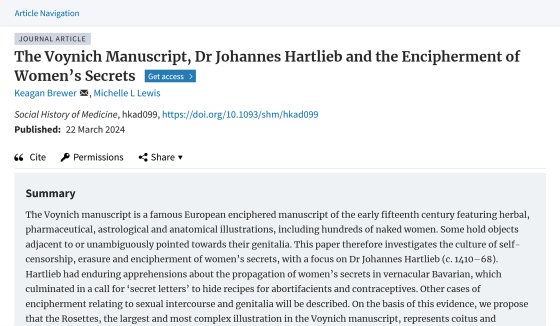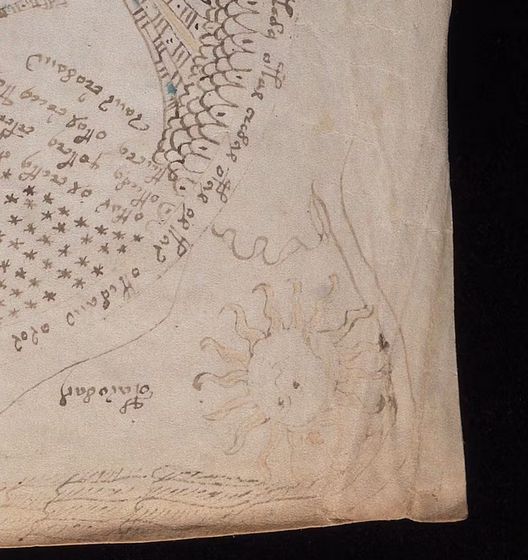Researchers claim that the Voynich manuscript contains 'sex secrets'

by Yale University Library
Voynich Manuscript, Dr Johannes Hartlieb and the Encipherment of Women's Secrets | Social History of Medicine | Oxford Academic
https://academic.oup.com/shm/advance-article-abstract/doi/10.1093/shm/hkad099/7633883

For 600 years the Voynich manuscript has remained a mystery. Now we think it's partly about sex
https://theconversation.com/for-600-years-the-voynich-manuscript-has-remained-a-mystery-now-we-think-its-partly-about-sex-227157
The Voynich Manuscript is decorated with mysterious pictures of stars, planets, plants, the zodiac , nude women, blue and green liquids, and the encrypted text has not yet been deciphered. However, past research has shown that the skin used for the manuscript is likely to have come from animals that died between 1404 and 1438 , and that the symbols of the zodiac, the crown design, and the distinctive shape of the castle walls indicate that it was created in a cultural region from southern Germany to northern Italy.
When studying the Voynich Manuscript, Macquarie University linguist Keegan Brewer and his colleagues focused on the numerous depictions of 'naked women.' In one section, a nude woman is depicted holding a strange object close to her genitals, something not found in books on fields such as herbalism or astronomy. So Brewer and his colleagues investigated the culture of gynecology and sexology in the late Middle Ages to look for clues about the Voynich Manuscript.

In a paper published in the medical history journal Social History of Medicine, Brewer and his colleagues cite
Hartleap also used codes and secret alphabets to obscure medical knowledge that could lead to contraception, abortion, etc. Although the 'secret alphabet' written by Hartleap no longer exists, his other writings suggest that he feared that his writings would encourage extramarital sex and incur the wrath of God.
Brewer points out that Hartleap's unencrypted writings reveal a reluctance to include information on vaginal ointments after childbirth, female sexual pleasure, testimonies from women who gave birth to animals, correct sex positions for conception, dietary advice to change libido, and information on plants used for contraception and abortion. Hartleap wrote in accessible Bavarian rather than academic Latin for male aristocrats, but believed knowledge of such subjects should be restricted to sex workers, commoners, children, and women.
In fact, in late medieval southern Germany and northern Italy, censorship of 'women's secrets' was carried out by third-party censors or by the authors themselves, Brewer says. When he examined the writings of that time, he found numerous cases of texts related to gynecology and sexology being encrypted, erased, or destroyed.
Considering this trend of the late Middle Ages and the tendencies of Hartleap's writings, it seems that the Voynich Manuscript can be interpreted as containing 'sex secrets.' Brewer gave the following illustration of nine circles connected to each other by tubes. In late medieval Europe, it was believed that 'the uterus had seven chambers and the vagina had two openings, an outer and an inner one,' and the nine circles in this illustration represent the uterus and vagina. Brewer and his colleagues claim that the upper left circle represents the inner opening of the vagina, the central circle with a jagged outer edge represents the outer opening of the vagina, and the remaining seven circles represent the uterus.


In addition, doctors at the time believed that conception required both male and female 'sperm' and that their movement in the uterus gave the woman pleasure. Brewer points out that the yellow and blue liquids depicted in the circle represent male and female 'sperm.'

The circle depicts castles and castle walls, which is because the German word 'schloss' (castle, mansion) has the meaning of 'female genitalia' or 'female pelvis.'

The suns in the upper left and upper right corners may reflect Aristotle's belief that the sun provides natural heat for the developing fetus.

'While the functions of many of the illustrations are not yet understood, our proposals merit close scrutiny, and we hope that future studies will approach this manuscript through a similar lens,' Brewer said.
Related Posts:
in Science, Posted by log1h_ik







